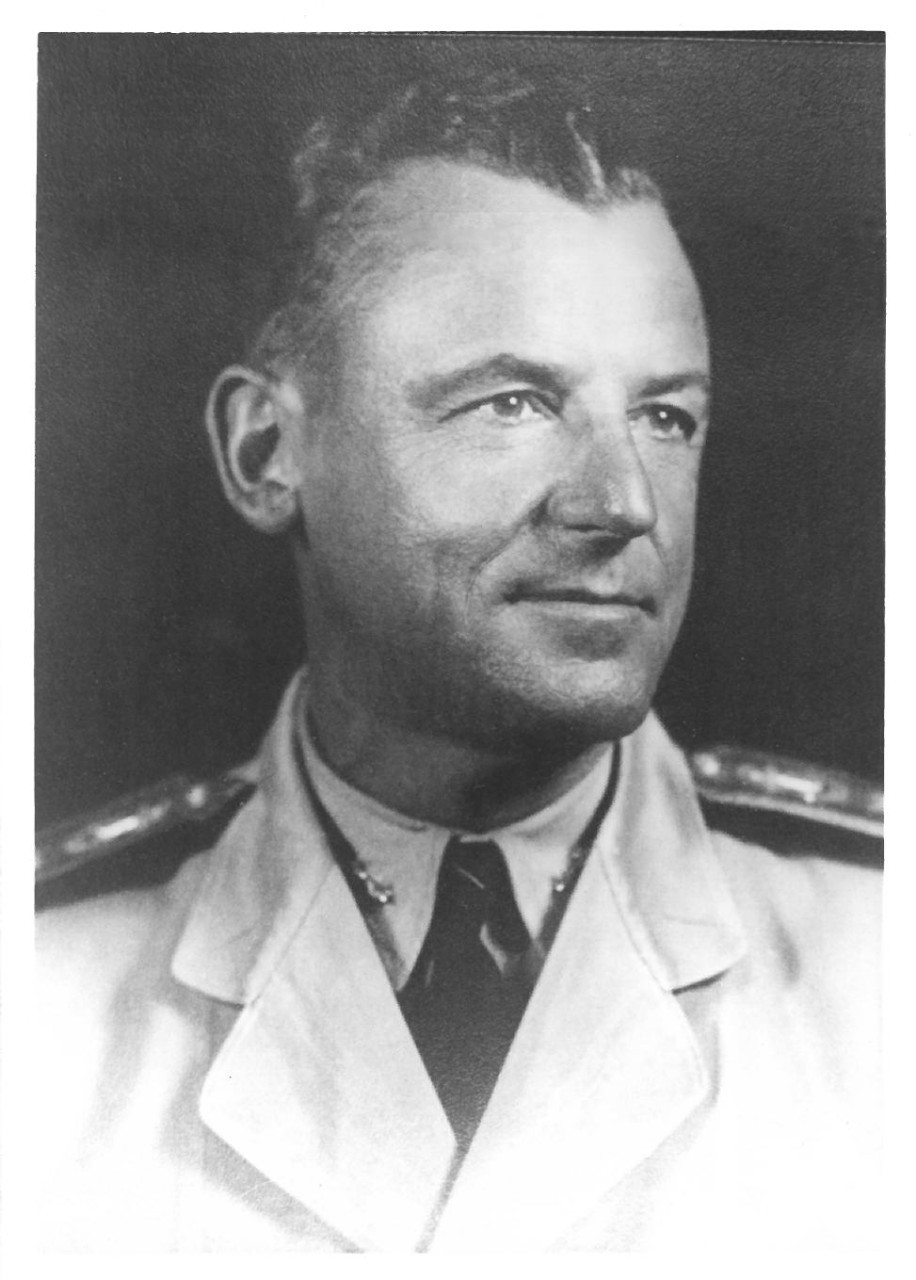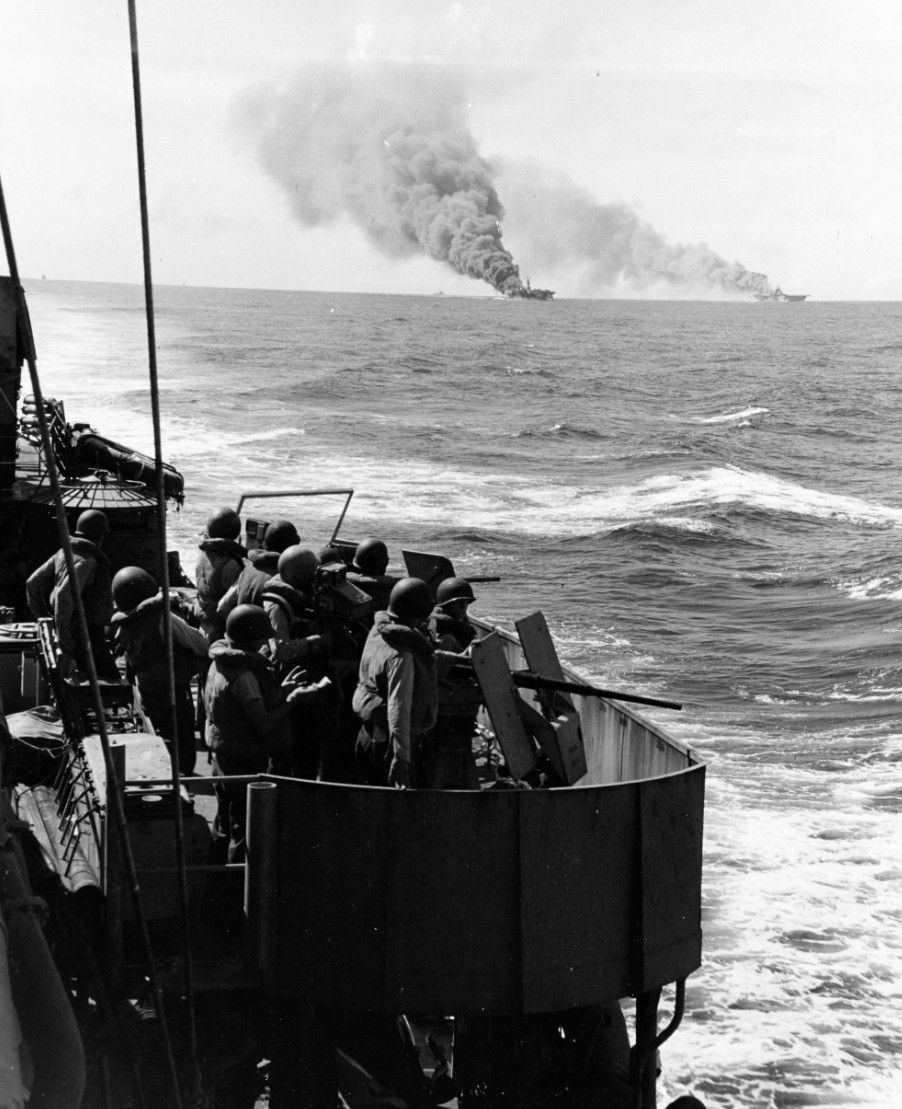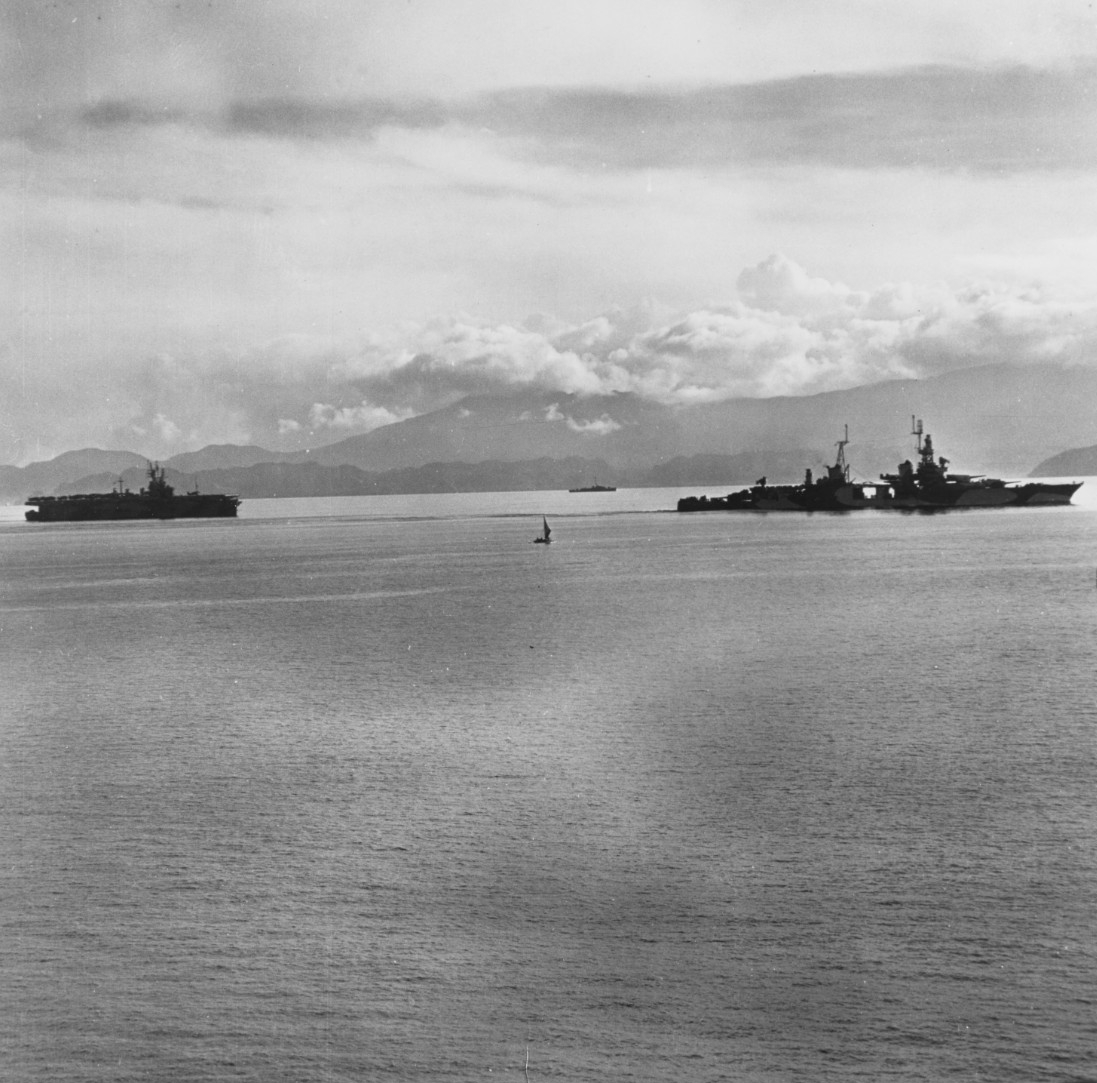H-Gram 040: “One Helluva Day”—Lingayen Gulf and the Death of Rear Admiral Theodore E. Chandler
9 January 2020
This H-gram covers:
- The combat death of Rear Admiral Theodore E. Chandler, 6 January 1945
- Actions in the Philippines in late 1944 and early 1945: Leyte, Ormoc, and Mindoro
- Amphibious landings in the Lingayen Gulf, 9 January 1945
Download a PDF of H-Gram 040 (5.4 MB).
The costly U.S. and Allied naval campaign in the Philippines required securing the island of Leyte, capturing the island of Mindoro, and then conducting the main amphibious landing on the island of Luzon at Lingayen Gulf under concerted and increasingly effective Japanese kamikaze attacks during the period of November 1944 to January 1945. The suicide attacks claimed the escort carrier Ommaney Bay (CVE-79) and caused serious damage to other major U.S. warships. The latter included the kamikaze strike on the heavy cruiser Louisville (CA-28) on 6 January 1945 that resulted in the death of Rear Admiral Theodore E. Chandler (USNA ’15), who was posthumously awarded a Navy Cross and Silver Star, and was one of four U.S. admirals killed in battle during World War II. Also covered is the posthumous Medal of Honor to the commanding officer of USS Walke (DD-723), Commander George F. Davis.
As always, you are welcome and encouraged to distribute H-grams widely. “Back issue” H-grams can be found here on the Naval History and Heritage Command website.
Overview
Japanese kamikaze pilots were briefed to strike U.S. ships in the bridge area in order to inflict maximum casualties on senior personnel and degrade the ship’s ability to conduct further operations. That’s exactly what the kamikaze pilot who attacked the heavy cruiser Louisville late on the afternoon of 6 January 1945 in Lingayen Gulf intended to do. Louisville was the flagship of Commander, Cruiser Division FOUR, Rear Admiral Theodore E. Chandler, assigned the task of bombarding Japanese positions ashore in advance of the amphibious landing planned for 9 January 1945. The previous day, Louisville had been hit by a kamikaze whose aim was slightly off and who impacted on the armored faceplate of turret No. 2 (the 8-inch triple turret just in front of the bridge). The strike only killed one man, but wounded 59, including Louisville’s commanding officer, Captain Rex Legrand Hicks, who continued to command his ship despite being severely burned before the extent of his injuries forced him to relinquish command to the executive officer (Hicks would be awarded a Silver Star for his gallantry).
The next day, “Lucky Lou’s” luck ran out. Despite intense anti-aircraft fire, the kamikaze hit Louisville right in the flag bridge area on the starboard side, with devastating result. Given the relative proximity of Japanese airfields on Luzon to the Lingayen beachhead area, the kamikaze still had a large amount of fuel. The resulting gasoline fireball turned the topside area on the forward superstructure into an inferno, killing many bridge personnel and gunners, who had stood their ground and fired at the plane until impact; 32 men would die and another 56 were wounded, many grievously. Rear Admiral Chandler was in an exposed weather position when the plane hit, jumping from the flag bridge to the signal bridge and emerging with his clothes on fire. Others doused the flames, and despite his severe injuries he assisted Sailors in manning a fire hose and then attempted to remain in command of his task force until finally being compelled by his chief of staff to seek medical attention, and even then refusing preferential treatment, patiently waiting his turn. Unfortunately, Chandler’s lungs had been severely scorched and despite the best efforts of the medical staff, he died the next day, and was buried at sea.
Chandler was the grandson of a Secretary of the Navy and son of a U.S. Navy rear admiral, and had graduated near the top of his class in Annapolis in 1915. He had distinguished himself even before World War II broke out, when in command of the elderly light cruiser Omaha (CL-4) in November 1941, he had identified a German blockade runner (Odenwald) disguised as a U.S. merchant ship in the South Atlantic. Chandler ordered Odenwald to stop and sent a boarding party, which went aboard the blockade runner just as the German scuttling charges went off. However, the boarding team was able to prevent the ship from sinking. A prize crew was put on board that took Odenwald to Puerto Rico (the boarding team and prize crew thus became the last U.S. Sailors to receive “prize money” for capturing a ship, although not until the court case was finally settled after the war). As a rear admiral, Chandler served with distinction in the Caribbean, the invasion of southern France (receiving a Legion of Merit for each tour), and as Battleship Division TWO commander during the Battle of Surigao Strait.
Chandler was posthumously awarded a Navy Cross (for Lingayen Gulf), a Silver Star (for Surigao Strait) and an Army Distinguished Service Medal (from General Douglas MacArthur). The Gearing-class destroyer Theodore E. Chandler (DD-717) was named in his honor and served from 1946 to 1975, earning nine battle stars in the Korean War and eight battle stars and a Navy Unit Commendation in the Vietnam War (and being hit by Communist shore fire in 1967). The Kidd-class guided missile destroyer Chandler (DDG-996) was also named in his honor and served from 1982 to 1999. For a short biography of Rear Admiral Chandler and text of his award citations, please see attachment H-040-1, which also includes a photo of Louisville being hit by a kamikaze at Lingayen Gulf on 6 January 1945.
The U.S. Navy was in for a rude shock after exalting in the great victory in the Battle of Leyte Gulf. There were many who believed that because of the staggering losses in ships, aircraft, and men that the Japanese had been “licked” and war would be over soon. However, not only did the Japanese not quit, they unleashed a fearsome new weapon, the manned suicide aircraft: the kamikaze (“divine wind”). The psychological impact was profound as ship after ship was hit by kamikaze, often with devastating results even when a ship wasn’t sunk. In the Philippines campaign, one out of four kamikaze hit a ship, many times in the bridge area. The kamikaze were harder to shoot down and would keep on coming no matter what: only the physical disintegration of the suicide aircraft would stop the attack once committed, and, even then, killing debris from the plane might hit the ship. The concept that an enemy would willingly kill themselves to achieve an outcome was unfathomable to most Americans. Navy leadership was so concerned about what the impact of suicide attacks might be on morale that for many months the Navy used wartime censorship to keep the fact of kamikaze attacks from the American public.
The Japanese kamikaze pilots were not crazy. By this time of the war, the Japanese were well aware that practically every plane that went out against a U.S. carrier task force failed to return—so even a conventional attack was essentially a suicide mission—and that every pilot’s days were almost certainly numbered anyway. The kamikaze pilots were volunteers, initially from among the most junior pilots, while the more senior and experienced pilots flew escort missions to help the kamikaze get to their targets. However, as the campaign went on, even the most senior Japanese pilots began flying suicide missions. By the time of the culmination of the Philippine campaign at Lingayen Gulf, U.S. ships were being hit by some exceptionally good pilots (far better than would be the case off Okinawa later in the spring of 1945).
Ultimately U.S. Navy Sailors responded to the kamikaze threat with grim determination and resolve equal to that of the enemy pilots. There are numerous examples of U.S. gunners standing their ground and firing on the kamikaze right up until the moment of impact, even in the face of certain death. The U.S. Navy responded with numerous operational and technical innovations that I will cover in a future H-gram, as most were not in effect (except the bravery of the gunners) during the Philippine campaign.
In the initial weeks after the Battle of Leyte Gulf, the battle ashore became a protracted campaign, in significant part due to delay in developing airfields for U.S. Army tactical aircraft. U.S. carriers and escort ships were forced to remain tethered to the Leyte area to provide critical air support, especially as the Japanese continued to flow aircraft into the area, and even at times achieved air superiority at night. This negated the advantage of naval mobility, and soon U.S. ships were frequently being hit by kamikaze and even a submarine. Several U.S. fleet carriers were put out of action by kamikaze strikes, including Franklin (CV-13), Belleau Wood (CVL-24), Lexington (CV-16), and Intrepid (CV-11), while light cruiser Reno (CL-96) was knocked out of the war by a submarine torpedo. Destroyer Abner Read (DD-526) was sunk with large loss of life.
In order to interrupt the flow of Japanese troops and material into the west side of Leyte via Ormoc Bay, U.S. destroyers and PT boats made sweeps before mounting an amphibious assault into the bay on 7 December 1944. These operations cost three destroyers and a destroyer-transport sunk: Cooper (DD-695) by torpedo in a surface action, and Mahan (DD-364), Reid (DD-639), and Ward (APD-16) by kamikaze (Cooper and Reid with heavy loss of life), along with numerous other ships damaged.
After Leyte, the next island to be taken was Mindoro. The landing on 15 December 1944 and occupation by the Army went well, but the approach and sustainment was very costly to the U.S. Navy. The first ship to be hit by a kamikaze was the flagship for the entire operation, the light cruiser Nashville (CL-43), with horrific casualties (133 dead). During the operation, two Liberty ships carrying ammunition, John Burke and Lewis L. Dyche, were hit by kamikaze and vaporized with their entire crews when they blew up. Numerous other Navy ships were hit and damaged. The Japanese even sent a cruiser-destroyer surface action group to attack the beachhead area, which was successful in catching the Americans by surprise, but not successful in the result, losing a destroyer to a U.S. PT boat (this would be the second-to-last offensive sortie by a Japanese navy force during the war).
For more detail on the costly battles around Leyte, the landings at Ormoc Bay, and the landings on Mindoro, please see attachment H-040-2.
The major U.S. invasion of Luzon took place on 9 January 1945 at the southern end of Lingayen Gulf, with pre-invasion bombardment commencing on 6 January, a date that naval historian Rear Admiral Samuel Eliot Morison described as “one helluva day” as kamikaze took a fearsome toll on U.S. ships and crews. The escort carrier Ommaney Bay (CVE-79) was sunk by a kamikaze on the transit to Lingayen. Louisville (CA-28), Columbia (CL-56), and HMAS Australia were hit by kamikaze on the transit. (Louisville would be hit twice, Columbia three times, and Australia five times during the operation.) In the Lingayen area, battleships New Mexico (BB-40), Mississippi (BB-41), and Vice Admiral Oldendorf’s flagship California (BB-44) would be hit with major casualties, with a British lieutenant general killed on New Mexico. Escort carriers Manila Bay (CVE-61), Savo Island (CVE-78), Kadashan Bay (CVE-76), Kitkun Bay (CVE-71), and Salamaua (CVE-96) were hit, along with numerous other ships, often in the bridge and often with heavy loss of life. The destroyer Walke (DD-723) was hit in the bridge, and her commanding officer, Commander George F. Davis, would be awarded a posthumous Medal of Honor for continuing to command his ship even while suffering mortal wounds as a “living torch.” The light cruiser Boise (CL-47), with General MacArthur aboard, was nearly hit by a torpedo from a Japanese midget submarine. The Japanese even used suicide boats in an attempt to inflict casualties during the landings. During the operation 45 U.S. and two Australian ships would be hit or suffer damaging near misses from kamikaze attacks or bombs.
In the end, the Japanese army chose not to defend Luzon at the Lingayen beachhead, and the landings by U.S. Army troops were essentially unopposed. In hindsight, the sacrifice of so many U.S. Sailors at Lingayen Gulf to conduct pre-landing bombardment was not necessary, but that detracts nothing from the extraordinary bravery of the Sailors and the resolve of the commanders to fight their way through to victory.
For more detail on the Lingayen landings, please see attachment H-040-3.
Sources for this H-gram are primarily the Naval History and Heritage Command Dictionary of American Fighting Ships (DANFS) for U.S. ships and combinedfleet.com for Japanese ships. Rear Admiral Samuel Eliot Morison’s two volumes, Leyte (XII) and The Liberation of the Philippines (XIII), from his History of United States Naval Operations in World War II series are key sources. Two very useful websites are the Military Times Hall of Valor (https://valor.militarytimes.com) for award citations, and USNA Virtual Memorial Hall (https: usnamemorialhall.org), since the great majority of ship/squadron commanding officers and senior Navy commanders at this time were Naval Academy graduates.





